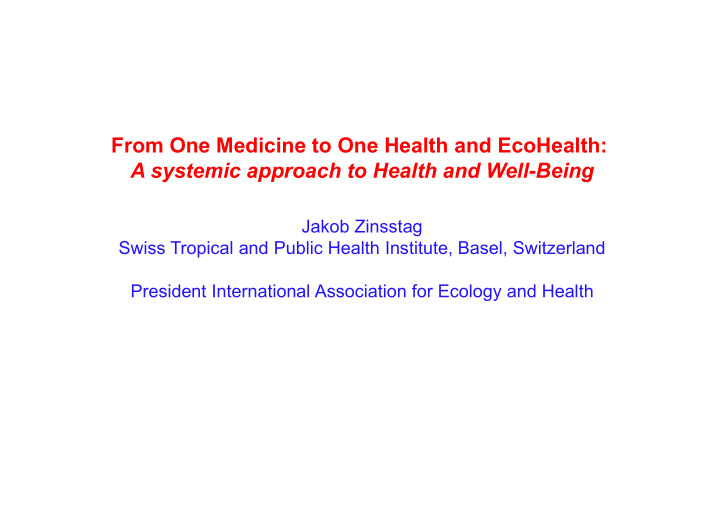



From One Medicine to One Health and EcoHealth: A systemic approach to Health and Well-Being Jakob Zinsstag Swiss Tropical and Public Health Institute, Basel, Switzerland President International Association for Ecology and Health
25. Januar 2016 Präsentationstitel 2
„One Health“ requirements • Necessary (but not sufficient) requirements: – Recognition of intextricable linkage of human, livestock, companion animal and wildlife health. • Sufficient requirements: – Added value of health and wellbeing of humans and animals and/or financial savings from closer cooperation of human and animal health. 25. Januar 2016 Präsentationstitel 3
Joint human and animal vaccinations improve access to health care for pastoralists (Schelling et al. 2007 EID) Costing study: public health sector could save up to 15% of infrastructure, cold chain and staff costs Private veterinarians’ interest in capitalising on transportation infrastructure 25. Januar 2016 4 4
Canadian Integrated Program for Antimicrobial Resistance Surveillance (CIPARS) www.phac-aspc.gc.ca/cipars-picra/index-eng.php 25. Januar 2016 Präsentationstitel 5
Parthenium hysterophorous (Famine Weed): A looming threat to KZN, South Africa Human health Domestic animals health The solution lies in Ecohealth based interventions 6 Wild animals health Implications on agriculture
Conceptual Framework for addressing Famine Weed induced challenges Socio-cultural Stigma Research Informed Interventions Remedies/IKS Human health application challenges Improved Compromised Human and human and Biodiversity Control Animal Animal Parthenium Wellbeing Wellbeing hysterophorus Competitive food Food security crops/control Remedies/IKS Animal health application challenges Exploring Unexploited potential benefits benefits 7
Partners for addressing Famine weed challenges STAKEHOLDERS • KwaZulu-Natal Parliamentarians • Departments of Health • Department of Environmental Affairs • Department of Agriculture, Forestry and Fisheries • Department of Rural Development and Land Reform • Department of Economic Development • Department of Social Development • Department of Science and Technology • Department of Human Settlements • Ezemvelo KZN Wildlife • South Africa National Space Agency (SANSA) • University of KwaZulu-Natal Scientists � Biodiversity � Health � Social � Economics � Indigenous Knowledge Systems (IKS) � Agriculture 8
Ecohealth Leveraging Green Space to Connect Environment & Health: Ontario examples Our goal is to develop new collaborations among the human health, social and environmental sectors and build a common agenda to foster improved health and well being outcomes for Ontarians through the provision of better ecosystem quality, Karen Morrison, PhD increased green space and Vice-President, IAEH enhanced access to nature. Adjunct Professor, York University, Canada
Examples of Activities to Date Officially began in 2015! Workshops: Shade Working Group and Forums: Health Benefits of Green Space Audits Mailing List: Several hundred interested parties • Newsletters • Increasing engagement • Local and provincial
Significance • Sectors see the value in collaboration/leveraging – Collective Impact approach – Mutually reinforcing activities – Policy, Research, Communication • Myriad of opportunities – Ample co-funding • foundations, environment and health NGOs, government agencies – Different lenses • chronic disease, climate change, biodiversity, etc. • Creating a new public space for discussions about the link between human health and the environment – Legitimizes concerns – Mobilizes action • No focus on zoonoses or animal health – Not well-served by the One Health concept
Lead in Human in Rural Area of Bangladesh • 183 school aged children – 14% (26) had blood lead levels > 10 μg/dL. • 16 parents – 25% (4) had blood lead levels > 10 μg/dL. • No obvious exposure to lead – Only industries: Brick kilns, fabric dying and weaving Mitra AK. Int J Environ Res Public Health. 2009;6(1):84-95 . 1.5 year old children (n=329) Mean 6.0 μg/L lead in urine Range (0.8 – 70) 5 year old children (n=335)Mean 5.3 μg/L lead in urine Range (0.7 – 26) Bergkvist C. Environ Res. 2010;110(7):718-24 • 430 Pregnant women – 13% had blood lead levels > 7 μg/dL • Pesticides and herbicides use, preparation and storage as a risk factor in case control study • Laboratory analysis of pesticides showed lead @32.1 ppm, Arsenic @ 10.5 ppm Steve Luby, OH Bangladesh ex-meeting 02 Sept, 2015, Dhaka
Lead in Foods and Vegetables in Bangladesh Lead in fresh milk Chittagong, Bangladesh • Fresh Milk sample from dairy farms Chittagong were tested • 6.3% cross the maximum tolerable level recommended by 10 μg/dL Talukder et al., 2014, CVASU MS thesis Lead in edible fish from fresh water Dhaka, Bangladesh • Lead concentration at dry muscle @2.08 µg/dl • EC maximum level of Pb in fish 0.96 µg/g dry weight • Per capita 21 g/person/day for males and females of all ages Islam et al., 2015, Hum Ecol Risk Assess, 21: 986–1006, 2015 Lead in fresh vegetable in coastal area, Bangladesh • 12 species of fresh vegetables (n=120) were tested • Pb ranges from 0.2 -1.2 mg/kg which exceed WHO/FAO 2012 recommended level • Estimated dietary intake (EDI) is 2.1 mg/day for Amaranthus hybridus Islam et al., 2015, Hum Ecol Risk Assess, 21: 986–1006, 2015
Community Engagement Participatory Research Good Agriculture & Environment Practice • • Healthy Environment for healthy people Ensuring safe food for betterment of next • Justified and sustainable use of pesticides/ generation • insecticides Understanding ecology and interrupt the • Wildlife and forest conservation transmission chain One Health One Health • Sustainable use of natural resources Solution Solution Control contamination at production level Anticona et al. BMC Public Health 2013, 13:437
Hendra – using a one health approach Bats Horses Amplification in a secondary host Man Dog Direct transmission to humans? (not so far!) Man Transmission Human to human? to humans and dogs (not so far!)
So what should we do? Disperse the bats Kill the bats! Keep bats and horses apart Treat infected humans Vaccinate humans (use of immune serum) Treat infected horses Vaccinate horses Destroy infected (suspect) Infected horses
Added-value created by a One-Health Approach • Hendra is an excellent example of what can be achieved • The outcomes in terms of protecting bats, managing the disease in horses and reducing the risk to humans coul d not have been achieved without a One Health approach • This approach included operational/field activities, policy setting and research prioritization and implementation
Recommend
More recommend